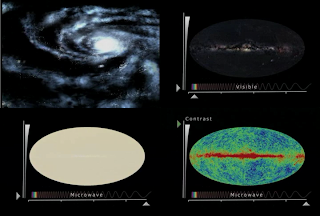Astronomy 10, Summer Session 2007
Cuesta College, San Luis Obispo, CA
Astronomy 10 learning goal Q6.1

Jupiter and Saturn
http://www.spirit-alembic.com/Issue5/jupiter-saturn.jpgStudents were asked the following clicker question (Classroom Performance System,
einstruction.com) near the beginning of their learning cycle:
[0.3 points.] Why is there less helium in the upper atmosphere of Saturn, compared to Jupiter?
(A) Saturn does not conduct as much electricity.
(B) Saturn was made out of less helium.
(C) Helium escaped to become rings.
(D) Saturn is cooler.
Correct answer:
not revealed yet (see discussion below).
The above question is asked after some preliminary discussion on mass, size, and density of Jupiter and Saturn, retention of core heat, and the generation of the belt-zone and cyclonic weather patterns. Since Saturn's rings have not yet been discussed, students are expecting it to be the cause of the lack of helium in Saturn's upper atmosphere, compared to Jupiter, which lacks prominent rings.
Student responses
Section 8027
(A) : 1 student
(B) : 0 students
(C) : 12 students
(D) : 0 students
Two coffee cups are brought out. Students are asked whether they are experienced coffee drinkers (as opposed to energy drink users), and are directed to the fact that while the same amount of sugar was stirred into either coffee cup, one cup was kept warm, while the other cup was chilled, before being asked the following clicker question.
[0.3 points.] Two cups of coffee each have three spoonfuls of sugar stirred into them. One cup is kept very hot, while the other cup is allowed to cool off. If you take a sip from just off the top of each cup, which will taste sweeter?
(A) The hotter cup of coffee will taste sweeter.
(B) The cooler cup of coffee will taste sweeter.
(C) (Both cups of coffee will taste equally sweet.)
(D) (Not enough information is given to determine which cup of coffee will taste sweeter.)
Correct answer: (A).
Student responses
Section 8027
(A) : 6 students
(B) : 7 students
(C) : 0 students
(D) : 0 students
Students offer that sip off of the top of the cold cup of coffee tastes less sweet because its sugar has settled into a sludge in the bottom of the cup. Then the first clicker question is put up again, to see if students make the connection.
[0.3 points.] Why is there less helium in the upper atmosphere of Saturn, compared to Jupiter?
(A) Saturn does not conduct as much electricity.
(B) Saturn was made out of less helium.
(C) Helium escaped to become rings.
(D) Saturn is cooler.
Correct answer: (A).
Student responses
Section 8027
(A) : 0 students
(B) : 1 student
(C) : 1 student
(D) : 11 students
In this model, Jupiter the hotter cup of coffee, while Saturn is the cooler cup of coffee (being smaller in mass, it did not have as much original formation and radioactive decay heat, and cooled off faster). Coffee represents hydrogen molecules, while sugar represents helium in the atmospheres of these jovian planets. Jupiter's warmer atmosphere allows it to keep helium suspended (sugar stays dissolved in hot coffee, due to the thermal motion of water molecules), while Saturn's atmosphere is too cool, and helium begins to fall inwards (sugar is allowed to precipitate). This explains both the lack of helium in the upper atmosphere of Saturn, and also the observation that while cooler Saturn has less active belt-zone and cyclonic weather patterns than Jupiter, Saturn is not as cool as expected for its mass, as helium condensation now provides a secondary source of energy for Saturn.
Further discussion of this model is covered in a subsequent post:
Jovian coffee model (2).













